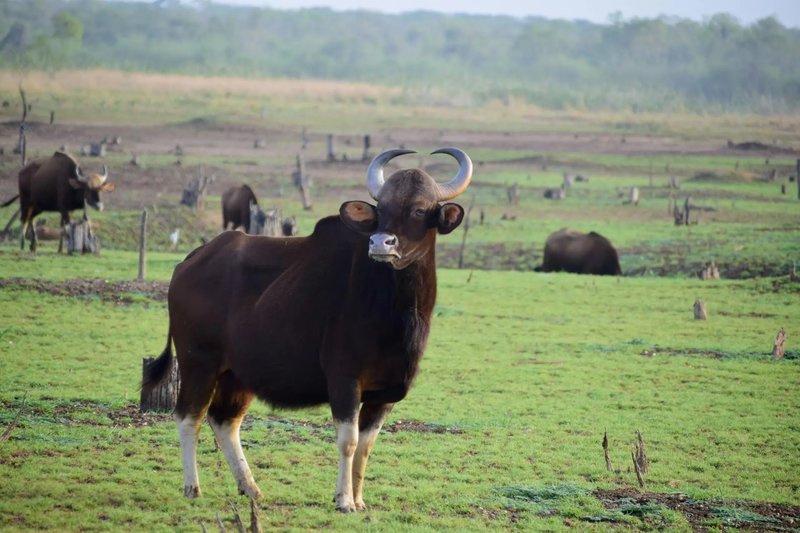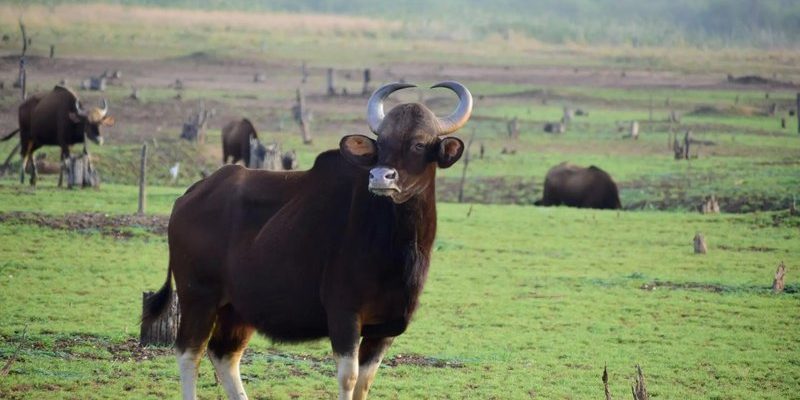
In the wild, a gaur’s diet largely influences its hunting strategies. But here’s the twist: while they’re primarily herbivores, they play a crucial role in maintaining the ecosystem. Picture them as nature’s lawnmowers, grazing through tall grasses, shrubs, and trees. So, what exactly do they eat, and how does that impact their interactions with their environment? Let’s explore this further!
Understanding the Gaur’s Diet
When it comes to eating, gaurs have a pretty varied menu. They primarily munch on grasses, leaves, and fruits, making them browsers and grazers. Here’s a closer look at what’s on their plate:
- Grasses: Gaurs are particularly fond of tender grass, which makes up a significant portion of their diet. They spend a large part of their day (up to 18 hours!) grazing to meet their nutritional needs.
- Leaves and Shoots: In addition to grass, gaurs enjoy munching on the leaves and shoots of shrubs and trees. This helps them get those essential vitamins and minerals.
- Fruits: During certain seasons, they’ll indulge in fruits like berries and other ripe morsels they can find in their habitat.
You might be wondering, “Why are they so picky with their food?” Well, they need to keep their energy levels high to support their massive bodies. A fully grown gaur can weigh up to 2,200 pounds! Maintaining that bulk requires a lot of food, and their grazing habits significantly contribute to the health of their ecosystem.
The Role of Grazing in Ecosystem Maintenance
Grazing isn’t just about survival for gaurs; it’s essential for the ecosystem. Here’s how their diet and feeding habits impact their environment:
- Promoting Plant Diversity: By feeding on various plants, gaurs help keep certain species in check, allowing others to thrive. This promotes biodiversity, which is crucial for a healthy ecosystem.
- Creating Habitats: Their grazing habits create open spaces in dense forests, allowing sunlight to reach the ground. This encourages the growth of new plants and helps smaller animals find shelter.
- Soil Fertility: As gaurs roam and graze, they also contribute to soil fertility through their droppings. This natural fertilizer boosts plant growth, benefiting the entire area.
It’s incredible to think that such a massive creature can play a significant role in maintaining balance in the ecosystem. Gaurs truly are the unsung heroes of the forest!
Hunting Strategies: Not What You Think
Now, here’s the catch: gaurs are herbivores and don’t hunt for food like carnivores do. However, they do have strategies for protecting themselves and their young from predators. Here’s how they navigate the wild:
- Group Living: Gaurs are social animals that often form herds. This not only allows them to graze efficiently but also offers protection against predators like tigers. There’s safety in numbers, right?
- Intimidation: When threatened, a gaur will often stand tall and puff itself up, showing off its size. This displays strength and can deter potential predators.
- Flight Response: If intimidation doesn’t work, gaurs can run surprisingly fast despite their size. They can bolt away to escape danger, using their strength and speed to their advantage.
So, while gaurs don’t hunt in the traditional sense, they’ve developed some clever strategies to stay safe in the wild.
Adaptations to Their Habitat
Gaurs are incredibly well-adapted to their surroundings. Found in tropical forests, grasslands, and even mountainous regions, they’ve got some unique traits that help them thrive in these environments.
- Strong Legs: Their powerful legs allow them to navigate hilly terrains and run swiftly when needed. This agility is vital for escaping predators.
- Thick Hide: Gaurs have a thick skin that protects them from insect bites and harsh weather conditions.
- Social Structure: The herd dynamics not only help protect the young but also ensure that the older members teach the younger ones about foraging and avoiding threats.
These adaptations play a crucial role in their survival, ensuring that gaurs remain a vital part of their ecosystem.
Impact of Habitat Loss
While gaurs are strong and resilient, they face significant threats from habitat loss and human activity. Here’s why we should care about their well-being:
- Deforestation: As forests are cleared for agriculture and urban development, gaurs lose their natural habitat. This makes it harder for them to find food and mates.
- Human-Wildlife Conflict: As humans encroach on their territory, conflicts arise. Gaurs may wander into farms seeking food, leading to dangerous encounters.
- Conservation Efforts: Many organizations are working to protect gaurs by creating reserves and promoting awareness about their importance in the ecosystem. Support for these initiatives is crucial for their survival.
It’s essential to remember that by protecting gaurs, we’re also defending the health of the forests they inhabit.
The diet and hunting strategies of the gaur may not be what you expected, right? While these creatures don’t hunt in the traditional sense, their role as grazers and their unique adaptations play an essential part in their ecosystems. Their impressive ability to shape their environment makes them vital to maintaining plant diversity and ecosystem health.
Understanding the challenges gaurs face is crucial for their continued survival. By supporting conservation efforts, we contribute to the preservation of this magnificent animal and the delicate balance of nature. So, the next time you hear about gaurs, remember that these gentle giants are more than just big animals—they’re key players in their ecosystems.

